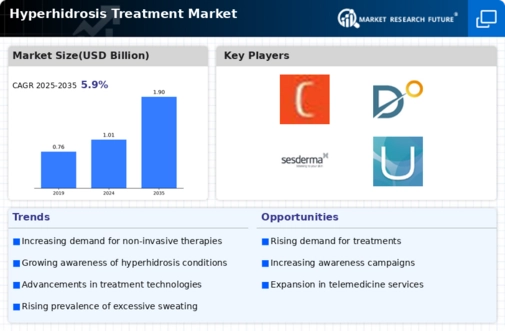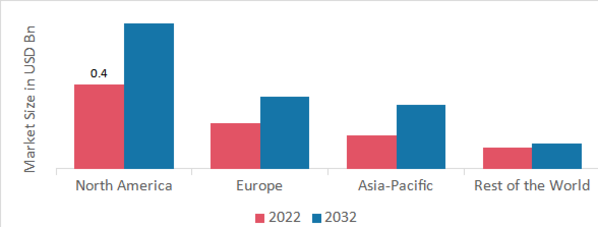Market Trends
Introduction
By 2025, the hyperhidrosis treatment market is experiencing a major transformation, influenced by a number of macroeconomic factors. The technological development of treatments, such as the development of minimally invasive procedures and the development of new formulations of drugs, will reshape the patient experience and outcomes. Meanwhile, the pressure of regulation is increasing, putting pressure on manufacturers to improve product safety and efficacy, and thereby increasing competition. In addition, changes in consumer behavior, characterized by increased awareness and demand for effective hyperhidrosis solutions, are forcing the market to adapt. These trends are strategically important because they influence not only the market dynamics, but also the research and development direction, and ultimately affect the patient experience and satisfaction.
Top Trends
-
Increased Awareness and Diagnosis
The rise in awareness of hyperhidrosis has increased the number of cases, with studies showing that nearly 3% of the world population suffers from it. Governments and health authorities are launching campaigns to raise awareness, which is pushing up demand for treatments. This trend is encouraging companies to invest in marketing and education. Awareness is likely to increase, and new patients will come to the market looking for effective treatments. -
Advancements in Treatment Technologies
The new technical innovations, such as microwave therapy and iontophoresis, are gaining ground. Companies like Dermira and Miramar Laboratories are developing less traumatic treatments with faster recovery times. These methods have been tested in clinical trials, and their effectiveness has been demonstrated, which has increased their use. Outpatient treatment is on the rise, which can improve throughput and reduce costs. -
Personalized Treatment Approaches
PERSONALISATION – The new trend towards individualized medicine is also influencing the treatment of hyperhidrosis. Companies are able to offer a wide range of individualized treatment plans based on genetic and biomarker data. This approach has been shown to improve patient satisfaction and clinical outcomes. As this trend develops, companies may need to invest in new diagnostic tools and in training for physicians. -
Regulatory Support for New Treatments
Regulatory authorities are becoming more and more supportive of the development of new hyperhidrosis therapies and are accelerating the approval of new products. For example, the FDA has created a specialized pathway for the approval of drugs and medical devices. This regulatory environment encourages the investment in R&D. As a result, companies can bring new products to the market more quickly, thereby increasing the competition and the number of available treatment options. -
Integration of Telemedicine
The telemedical revolution is transforming the way patients with hyperhidrosis are treated, allowing for remote consultations and follow-ups. A pandemic such as CovId-19 has increased the trend towards remote consultation, and many patients are now choosing this mode of treatment. And companies are responding to this new demand by offering an on-line platform for consultation and prescription. Reduced operating costs and increased access to care, especially in underserved areas, are the advantages. -
Focus on Combination Therapies
The combined treatment of hyperhidrosis is becoming the mainstay of treatment, as it can increase the effectiveness and reduce the side effects of the treatment. The combination of botulinum toxin and topical agents has been shown to be the most effective. These combinations are being tested in clinical trials and may lead to new products. This trend may change the market dynamics as physicians will have to change their treatment protocol. -
Emergence of Home Treatment Devices
It is with increasing speed that the development of devices for the treatment of hyperhidrosis is proceeding, which will permit patients to take charge of their condition at their own homes. Such is the trend, and companies such as Dermadry are at the forefront, with their FDA-approved devices for home use. Research shows that patients prefer the convenience of home treatment. This trend could cause a radical change in the traditional treatment model. It will be necessary for the clinics to adapt in order to remain competitive. -
Increased Investment in Clinical Research
A marked increase in the clinical research on hyperhidrosis is taking place, and companies are investing more and more in the study of the disease. This trend is also favoured by the development of co-operation between pharmaceutical companies and scientific institutions. Consequently, it is likely that new therapeutic options will be discovered. In the next few years, the market may see a greater choice of effective treatments. -
Growing Demand for Non-Invasive Procedures
The demand for non-surgical treatments is on the rise, and the demand for effective treatments with a short recovery time is growing. There are now alternatives to traditional treatments, such as the use of ultrasound and laser therapy. The companies are responding by extending their product range to include these new methods. This development will have an impact on the competitive situation, as companies that offer non-surgical solutions will be able to draw on a larger patient base. -
Sustainability in Product Development
The development of hyperhidrosis remedies is now based on sustainable development and eco-friendly practices. This means, for example, that the packaging materials used are made of sustainable materials, and that the manufacturing process does not produce any waste. As consumers become more aware of the environment, companies that focus on sustainable development may gain a competitive advantage. This could lead to a change in the industry's supply chain practices.
Conclusion: Navigating Hyperhidrosis Market Dynamics
The hyperhidrosis treatment market is characterized by intense competition and a high degree of fragmentation, with a number of companies both established and emerging. In addition, the growing awareness of hyperhidrosis and the increasing number of treatment options have led to an increased demand for new products, especially in North America and Europe. Companies are strategically repositioning themselves, using advanced technology such as artificial intelligence for individualized treatment plans, automation for more efficient service provision, and a sustainable approach to appeal to consumers. In this changing market, a flexible product portfolio and the ability to adapt to the needs of consumers are important to establishing a position as a leader. Strategic considerations for decision-makers wishing to successfully navigate the hyperhidrosis treatment market and seize emerging opportunities are therefore essential.







Leave a Comment